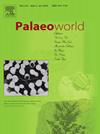来自美国内华达州埃尔科卡林峡谷塞普霍维亚通卡地层的腕足类:系统学和生物地层学
IF 1.7
3区 地球科学
Q2 PALEONTOLOGY
引用次数: 0
摘要
通过对美国内华达州埃尔科卡林峡谷上密西西比统通卡地层中的腕足类群进行系统研究,发现了 13 个物种,分别代表 12 个属和 7 个目:产品目中的 Antiquatonia sp.、Flexaria sp.、Marginatia sp.、Echinoconchus sp.、Orthetida 的 Orthotetes sp.、Rhipidomella sp.、Schizophoria sp、的 Echinoconchus sp.,直翅目的 Orthotetes sp.,直翅目的 Rhipidomella sp.、Schizophoria sp.,甲壳纲的 Cleiothyridina cf. sublamellosa Hall, 1858, Composita sulcata Weller, 1914,螺旋纲的 Anthracospirifer shawi shawi Gordon, 1975, Anthracospirifer aff.和 Terebratulida 的 Girtyella indianensis Girty, 1909,以及 Delthyridina 的一个未确定的线虫属和一个属,可能还有两个未确定的种。该动物群与北美西部的上切斯特期(Serpukhovian 中期)Carlinia phillipsi 和 C. amsdeniana 动物群有亲缘关系,但 Composita sulcata 的出现使其也接近于上切斯特期动物群(Rhipidomella nevadensis 和 Composita popsiensis 区,Serpukhovian 上期)。从属一级的组成来看,所记录的动物群关联是卡特(1990a)的腕足动物单元 16 的特征。第 16 单元横跨中切斯特期(Gnathodus bilineatus 锥齿轮区)至上切斯特期(Rachistognathus muricatus 锥齿轮区),相当于上维西期-上塞普霍夫期。同一地点出土的一个单特异性的 Vogegnathus postcampbelli 锥齿动物群证实了该动物群的晚切斯特期(Serpukhovian)时代。本文章由计算机程序翻译,如有差异,请以英文原文为准。
Brachiopods from the Serpukhovian Tonka Formation of Carlin Canyon, Elko, Nevada (USA): Systematics and biostratigraphy
Systematic study of a brachiopod assemblage from the Upper Mississippian Tonka Formation in Carlin Canyon, Elko, Nevada, USA, led to the recognition of 13 species, representing 12 genera and seven orders: ?Antiquatonia sp., Flexaria sp., ?Marginatia sp., Echinoconchus sp. of the Productida, ?Orthotetes sp. of the Orthotetida, Rhipidomella sp., Schizophoria sp. of the Orthida, Cleiothyridina cf. sublamellosa Hall, 1858, Composita sulcata Weller, 1914 of the Athyridida, Anthracospirifer shawi shawi Gordon, 1975, Anthracospirifer aff. A. shawi of the Spiriferida, Punctospirifer sp. of the Spiriferinida, and Girtyella indianensis Girty, 1909 of the Terebratulida, with the addition of one undetermined linoproductid and one genus and possibly two undetermined species of the Delthyridina. The assemblage shares affinities with upper Chesterian (middle Serpukhovian) Carlinia phillipsi and C. amsdeniana associations from western North American units, though the presence of Composita sulcata makes it also close to uppermost Chesterian faunas (Rhipidomella nevadensis and Composita popsiensis zones, upper Serpukhovian). The recorded faunal association, in terms of composition at the genus-level, is characteristic of brachiopod Unit 16 of Carter (1990a). Unit 16 spans the middle Chesterian (Gnathodus bilineatus conodont Zone) to upper Chesterian (Rachistognathus muricatus conodont Zone), corresponding to the upper Visean–Serpukhovian interval. A monospecific Vogegnathus postcampbelli conodont assemblage from the same locality confirms a late Chesterian (Serpukhovian) age of the fauna.
求助全文
通过发布文献求助,成功后即可免费获取论文全文。
去求助
来源期刊

Palaeoworld
PALEONTOLOGY-
CiteScore
4.00
自引率
5.90%
发文量
95
期刊介绍:
Palaeoworld is a peer-reviewed quarterly journal dedicated to the study of past life and its environment. We encourage submission of original manuscripts on all aspects of palaeontology and stratigraphy, comparisons of regional and global data in time and space, and results generated by interdisciplinary investigations in related fields. Some issues will be devoted entirely to a special theme whereas others will be composed of contributed articles. Palaeoworld is dedicated to serving a broad spectrum of geoscientists and palaeobiologists as well as serving as a resource for students in fields as diverse as palaeobiology, evolutionary biology, taxonomy and phylogeny, geobiology, historical geology, and palaeoenvironment.
Palaeoworld publishes original articles in the following areas:
•Phylogeny and taxonomic studies of all fossil groups
•Biostratigraphy, chemostratigraphy, chronostratigraphy
•Palaeoecology, palaeoenvironment and global changes throughout Earth history
•Tempo and mode of biological evolution
•Biological events in Earth history (e.g., extinctions, radiations)
•Ecosystem evolution
•Geobiology and molecular palaeobiology
•Palaeontological and stratigraphic methods
•Interdisciplinary studies focusing on fossils and strata
 求助内容:
求助内容: 应助结果提醒方式:
应助结果提醒方式:


